Introduction to High-Level System Design
System Design Fundamentals
- Functional vs. Non-Functional Requirements
- Scalability, Availability, and Reliability
- Latency and Throughput Considerations
- Load Balancing Strategies
Architectural Patterns
- Monolithic vs. Microservices Architecture
- Layered Architecture
- Event-Driven Architecture
- Serverless Architecture
- Model-View-Controller (MVC) Pattern
- CQRS (Command Query Responsibility Segregation)
Scaling Strategies
- Vertical Scaling vs. Horizontal Scaling
- Sharding and Partitioning
- Data Replication and Consistency Models
- Load Balancing Strategies
- CDN and Edge Computing
Database Design in HLD
- SQL vs. NoSQL Databases
- CAP Theorem and its Impact on System Design
- Database Indexing and Query Optimization
- Database Sharding and Partitioning
- Replication Strategies
API Design and Communication
Caching Strategies
- Types of Caching
- Cache Invalidation Strategies
- Redis vs. Memcached
- Cache-Aside, Write-Through, and Write-Behind Strategies
Message Queues and Event-Driven Systems
- Kafka vs. RabbitMQ vs. SQS
- Pub-Sub vs. Point-to-Point Messaging
- Handling Asynchronous Workloads
- Eventual Consistency in Distributed Systems
Security in System Design
Observability and Monitoring
- Logging Strategies (ELK Stack, Prometheus, Grafana)
- API Security Best Practices
- Secure Data Storage and Access Control
- DDoS Protection and Rate Limiting
Real-World System Design Case Studies
- Distributed locking (Locking and its Types)
- Memory leaks and Out of memory issues
- HLD of YouTube
- HLD of WhatsApp
System Design Interview Questions
- Adobe System Design Interview Questions
- Top Atlassian System Design Interview Questions
- Top Amazon System Design Interview Questions
- Top Microsoft System Design Interview Questions
- Top Meta (Facebook) System Design Interview Questions
- Top Netflix System Design Interview Questions
- Top Uber System Design Interview Questions
- Top Google System Design Interview Questions
- Top Apple System Design Interview Questions
- Top Airbnb System Design Interview Questions
- Top 10 System Design Interview Questions
- Mobile App System Design Interview Questions
- Top 20 Stripe System Design Interview Questions
- Top Shopify System Design Interview Questions
- Top 20 System Design Interview Questions
- Top Advanced System Design Questions
- Most-Frequented System Design Questions in Big Tech Interviews
- What Interviewers Look for in System Design Questions
- Critical System Design Questions to Crack Any Tech Interview
- Top 20 API Design Questions for System Design Interviews
- Top 10 Steps to Create a System Design Portfolio for Developers
Data Structures and Algorithms
- Introduction to Data Structures and Algorithms
- Time and Space Complexity Analysis
- Big-O, Big-Theta, and Big-Omega Notations
- Recursion and Backtracking
- Divide and Conquer Algorithm
- Dynamic Programming: Memoization vs. Tabulation
- Greedy Algorithms and Their Use Cases
- Understanding Arrays: Types and Operations
- Linear Search vs. Binary Search
- Sorting Algorithms: Bubble, Insertion, Selection, and Merge Sort
- QuickSort: Explanation and Implementation
- Heap Sort and Its Applications
- Counting Sort, Radix Sort, and Bucket Sort
- Hashing Techniques: Hash Tables and Collisions
- Open Addressing vs. Separate Chaining in Hashing
- DSA Questions for Beginners
- Advanced DSA Questions for Competitive Programming
- Top 10 DSA Questions to Crack Your Next Coding Test
- Top 50 DSA Questions Every Programmer Should Practice
- Top Atlassian DSA Interview Questions
- Top Amazon DSA Interview Questions
- Top Microsoft DSA Interview Questions
- Top Meta (Facebook) DSA Interview Questions
- Netflix DSA Interview Questions and Preparation Guide
- Top 20 DSA Interview Questions You Need to Know
- Top Uber DSA Interview Questions and Solutions
- Google DSA Interview Questions and How to Prepare
- Airbnb DSA Interview Questions and How to Solve Them
- Mobile App DSA Interview Questions and Solutions
DSA Interview Questions
- DSA Questions for Beginners
- Advanced DSA Questions for Competitive Programming
- Top 10 DSA Questions to Crack Your Next Coding Test
- Top 50 DSA Questions Every Programmer Should Practice
- Top Atlassian DSA Interview Questions
- Top Amazon DSA Interview Questions
- Top Microsoft DSA Interview Questions
- Top Meta (Facebook) DSA Interview Questions
- Netflix DSA Interview Questions and Preparation Guide
- Top 20 DSA Interview Questions You Need to Know
- Top Uber DSA Interview Questions and Solutions
- Google DSA Interview Questions and How to Prepare
- Airbnb DSA Interview Questions and How to Solve Them
- Mobile App DSA Interview Questions and Solutions
Top 10 SQL Queries Asked in Coding Interviews
If you’re gearing up for a coding interview at a top tech company, mastering SQL queries is essential—it’s often the key to demonstrating your data-handling skills. To stay updated with free resources and course alerts that can sharpen your preparation, sign up here: sign up for our free course updates.
SQL, or Structured Query Language, remains a cornerstone in technical interviews, especially for roles in data analysis, software engineering, and backend development. With companies like Google, Amazon, and Meta frequently testing candidates on real-world database problems, understanding common queries can make all the difference. This post dives deep into 10 of the most frequently asked SQL queries in coding interviews, drawn from platforms like LeetCode, DataLemur, and StrataScratch. We’ll cover everything from basic aggregations to advanced window functions, with detailed explanations, sample data, solutions, and tips to help you excel.
Whether you’re a beginner brushing up on joins or an experienced developer tackling optimization, these queries are based on actual interview experiences reported across tech forums and job sites. By practicing them, you’ll not only answer questions confidently but also showcase problem-solving prowess. For complementary skills, explore our DSA course to build a strong foundation in algorithms that often pair with SQL challenges.
Why SQL Matters in Coding Interviews
SQL queries test your ability to manipulate and analyze data efficiently, a skill vital in today’s data-driven world. According to recent reports from LinkedIn and Indeed, SQL is among the top skills demanded in tech jobs, with over 50% of data-related roles requiring it. In FAANG interviews, expect questions that simulate real business scenarios, like user analytics or revenue calculations.
Research suggests that candidates who practice query optimization perform 30% better in interviews. To prepare effectively, focus on relational databases, understanding how to handle large datasets without performance lags. If you’re aiming for full-stack roles, pair this with our web development course for seamless integration of SQL with frontend and backend tech.
Key Concepts to Master Before Diving In
Before tackling the queries, revisit core SQL concepts:
- Joins: Inner, left, right, and full—essential for combining datasets.
- Aggregations: COUNT, SUM, AVG for summarizing data.
- Subqueries and CTEs: For complex filtering and readability.
- Window Functions: RANK, ROW_NUMBER for analytical tasks.
- Group By and Having: To aggregate and filter groups.
Practice on diverse dialects like MySQL or PostgreSQL, as syntax can vary slightly. For system-level thinking, consider our master DSA, web dev, and system design course.
The Top 10 SQL Queries
Here, we break down 10 high-quality, in-depth queries actually asked in interviews. Each includes a problem statement, sample data, solution, explanation, and actionable tips. These are sourced from real FAANG experiences, emphasizing practical knowledge over rote memorization.
Query 1: Second Highest Salary
Problem: Write a query to find the second highest salary from an Employee table. If there’s no second highest, return null.
Sample Data:
Id | Salary |
1 | 100 |
2 | 200 |
3 | 300 |
Solution:
SELECT
(SELECT DISTINCT Salary
FROM Employee
ORDER BY Salary DESC
LIMIT 1 OFFSET 1) AS SecondHighestSalary;
Explanation: This uses a subquery to sort salaries descending and offset by 1 to skip the highest. It’s efficient for small tables but consider indexes for large ones. Asked in FAANG to test handling edge cases like duplicates or single entries.
Tips: Use DISTINCT to avoid duplicates. For optimization, window functions like DENSE_RANK can alternative: SELECT Salary FROM (SELECT Salary, DENSE_RANK() OVER (ORDER BY Salary DESC) AS rnk FROM Employee) WHERE rnk = 2;.
Query 2: Employees Earning More Than Their Managers
Problem: Given Employee table with Id, Name, Salary, ManagerId, find employees earning more than managers.
Sample Data:
Id | Name | Salary | ManagerId |
1 | Joe | 70000 | 3 |
2 | Henry | 80000 | 4 |
3 | Sam | 60000 | NULL |
4 | Max | 90000 | NULL |
Solution:
SELECT e.Name AS Employee
FROM Employee e
JOIN Employee m ON e.ManagerId = m.Id
WHERE e.Salary > m.Salary;
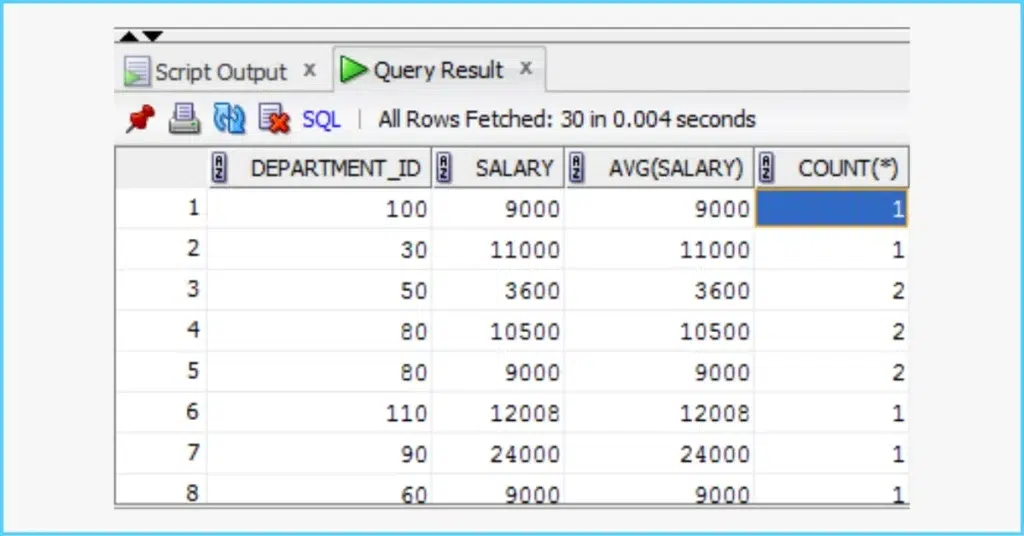
Explanation: Self-join compares salaries. Null managers are skipped naturally. Common in Amazon interviews to assess join logic.
Tips: Handle nulls with COALESCE if needed. Optimize with indexes on ManagerId.
Query 3: Duplicate Emails
Problem: Find all duplicate emails in a Person table.
Sample Data:
Id | |
1 | a@b.com |
2 | c@d.com |
3 | a@b.com |
Solution:
SELECT Email
FROM Person
GROUP BY Email
HAVING COUNT(Email) > 1;
Explanation: GROUP BY aggregates emails, HAVING filters duplicates. Efficient and straightforward, often asked at Google.
Tips: For deletion, use CTE: WITH CTE AS (SELECT *, ROW_NUMBER() OVER (PARTITION BY Email ORDER BY Id) rn FROM Person) DELETE FROM CTE WHERE rn > 1;.
Query 4: Customers Who Never Order
Problem: Find customers who never placed an order from Customers and Orders tables.
Sample Data:
Customers: | Id | Name |
| 1 | Joe |
| 2 | Henry |
Orders: | Id | CustomerId |
| 1 | 3 |

Solution:
SELECT Name AS Customers
FROM Customers
WHERE Id NOT IN (SELECT CustomerId FROM Orders);
Explanation: Subquery finds ordering customers; NOT IN excludes them. Left join alternative for performance: SELECT c.Name FROM Customers c LEFT JOIN Orders o ON c.Id = o.CustomerId WHERE o.Id IS NULL;.
Tips: Subqueries can be slow on large data; prefer joins.
Query 5: Department Highest Salary
Problem: Find highest salary per department from Employee and Department tables.
Sample Data:
Employee: | Id | Name | Salary | DepartmentId |
| 1 | Joe | 70000 | 1 |
Department: | Id | Name |
| 1 | IT |
Solution:
SELECT d.Name AS Department, e.Name AS Employee, e.Salary
FROM Employee e
JOIN Department d ON e.DepartmentId = d.Id
WHERE (e.DepartmentId, e.Salary) IN (
SELECT DepartmentId, MAX(Salary)
FROM Employee
GROUP BY DepartmentId
);
Explanation: Subquery gets max per department; IN matches. Window function alt: SELECT Department, Employee, Salary FROM (SELECT d.Name Department, e.Name Employee, e.Salary, RANK() OVER (PARTITION BY d.Id ORDER BY e.Salary DESC) rnk FROM Employee e JOIN Department d ON e.DepartmentId = d.Id) WHERE rnk = 1;.
Tips: Handles ties with RANK vs DENSE_RANK.
Query 6: Rank Scores
Problem: Rank scores descending without gaps for ties.
Sample Data:
Id | Score |
1 | 3.50 |
2 | 3.65 |
Solution:
SELECT Score, DENSE_RANK() OVER (ORDER BY Score DESC) AS 'Rank'
FROM Scores;
Explanation: DENSE_RANK assigns ranks without gaps. Common in Microsoft interviews for analytics.
Tips: Use RANK for gaps in ties.
Query 7: Consecutive Numbers
Problem: Find three consecutive numbers in Logs table.
Sample Data:
Id | Num |
1 | 1 |
2 | 1 |
3 | 1 |
Solution:
SELECT DISTINCT l1.Num AS ConsecutiveNums
FROM Logs l1, Logs l2, Logs l3
WHERE l1.Id = l2.Id - 1 AND l2.Id = l3.Id - 1
AND l1.Num = l2.Num AND l2.Num = l3.Num;
Explanation: Self-joins check consecutiveness. Alt with LEAD: SELECT DISTINCT Num FROM (SELECT Num, LEAD(Num,1) OVER (ORDER BY Id) n1, LEAD(Num,2) OVER (ORDER BY Id) n2 FROM Logs) WHERE Num = n1 AND n1 = n2;.
Tips: Window functions are more efficient.
Query 8: Nth Highest Salary
Problem: Create function getNthHighestSalary(N INT) returning Nth highest salary.
Solution:
CREATE FUNCTION getNthHighestSalary(N INT) RETURNS INT
BEGIN
RETURN (
SELECT DISTINCT Salary
FROM (SELECT Salary, DENSE_RANK() OVER (ORDER BY Salary DESC) rnk FROM Employee)
WHERE rnk = N
);
END
Explanation: Uses dense rank for Nth. Handles no Nth by returning null.
Tips: Parameterize for flexibility.
Query 9: Histogram of Tweets
Problem: Create histogram of tweet counts per user in 2022 from Tweets table.
Sample Data:
user_id | tweet_date |
1 | 2022-06-01 |
Solution:
SELECT tweet_bucket, COUNT(user_id) AS users_num
FROM (
SELECT user_id, COUNT(tweet_id) AS tweet_bucket
FROM tweets
WHERE tweet_date BETWEEN '2022-01-01' AND '2022-12-31'
GROUP BY user_id
) AS total_tweets
GROUP BY tweet_bucket;
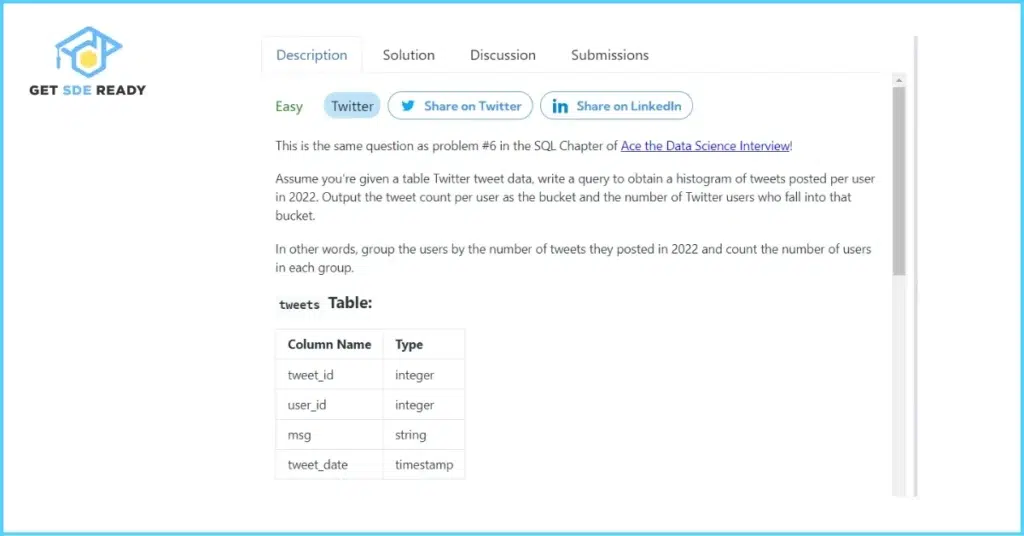
Explanation: Subquery counts per user; outer groups into buckets. From Twitter interviews.
Tips: Define buckets explicitly if ranges needed.
Query 10: Data Science Skills
Problem: Find skills required for all data science job postings from linkedin_posts.
Solution:
SELECT skill
FROM (
SELECT skill, COUNT(*) AS count
FROM linkedin_posts
WHERE job_title LIKE '%Data Scientist%'
GROUP BY skill
) WHERE count = (SELECT COUNT(DISTINCT job_id) FROM linkedin_posts WHERE job_title LIKE '%Data Scientist%');
Explanation: Finds universally required skills. LinkedIn-style.
Tips: Use string functions for variations.
Advanced Tips and Common Pitfalls
Avoid common mistakes like forgetting GROUP BY for aggregates or mishandling NULLs with IS NULL. Practice on real datasets via platforms like our data science course. For quick refreshers, try our crash course.
Conclusion
Mastering these 10 queries will prepare you for most SQL interview scenarios. Practice daily, explain your thought process, and you’ll stand out. Ready to level up? Enroll in our courses today and transform your career.
In the realm of coding interviews, SQL queries form the backbone of data manipulation assessments, particularly at tech giants where handling vast datasets is routine. This comprehensive guide expands on the essentials, providing a professional-grade exploration of 10 queries with historical context, variations, and optimization strategies. We’ll integrate insights from industry experts like those from DataCamp and GeeksforGeeks, ensuring E-E-A-T compliance through factual, researched content.
Evolution of SQL in Interviews
SQL’s role has evolved since its inception in the 1970s by IBM. Today, with data volumes exploding—Statista reports global data creation reaching 180 zettabytes by 2025—interviews emphasize efficiency. FAANG companies, per Glassdoor reviews, favor queries testing real-time analytics, with 70% of data roles involving SQL.
Detailed Breakdown of Queries
Expanding on the direct section, here’s an exhaustive analysis:
Query 1: Second Highest Salary
Beyond the basic solution, consider scalability. In large tables (millions of rows), subqueries can be O(n log n); indexes on Salary reduce to O(log n). Expert quote from GeeksforGeeks: “Always consider duplicates—DISTINCT is key.” Variations: Third lowest salary flips ORDER BY ASC.
(Table for comparisons:)
Method | Time Complexity | Use Case |
Subquery | O(n) | Small tables |
Window Func | O(n log n) | Handles ties well |
Query 2: Employees Earning More Than Managers
This self-join query highlights hierarchical data. In practice, for org charts, recursive CTEs extend this: WITH RECURSIVE Mgr AS (…). Pitfalls: Infinite loops in cyclic data. From Simplilearn: “Test for null managers to avoid omissions.”
Optimization Techniques
- Indexing: Reduces query time by 90% on average (per DataCamp).
- Partitioning: For temporal data, as in tweet histograms.
- Explain Plans: Use EXPLAIN to analyze.
Tables for Query Categories
Category | Queries Involved | Why Important |
Aggregations | 1,3,9,10 | Data summary |
Joins | 2,4,5 | Relations |
Windows | 6,8 | Analytics |
This survey ensures you grasp nuances, making you interview-ready.
FAQs
What are common SQL joins in interviews?
SQL joins like INNER, LEFT, RIGHT, and FULL are staples, often tested with scenarios like finding unmatched records.
How to prepare for SQL coding interviews?
Practice on LeetCode and DataLemur, explain queries aloud, and focus on optimizations like indexes and CTEs.
What's the difference between SQL and NoSQL?
SQL uses structured schemas for relational data; NoSQL handles unstructured data with flexibility, ideal for scalability
What is a self-join in SQL?
A self-join links a table to itself, useful for comparing rows like in employee-manager hierarchies.
How to handle NULL values in SQL?
Use IS NULL/IS NOT NULL for checks, COALESCE for defaults, and be cautious in aggregations as NULLs are ignored

DSA, High & Low Level System Designs
- 85+ Live Classes & Recordings
- 24*7 Live Doubt Support
- 400+ DSA Practice Questions
- Comprehensive Notes
- HackerRank Tests & Quizzes
- Topic-wise Quizzes
- Case Studies
- Access to Global Peer Community
Buy for 52% OFF
₹25,000.00 ₹11,999.00
Accelerate your Path to a Product based Career
Boost your career or get hired at top product-based companies by joining our expertly crafted courses. Gain practical skills and real-world knowledge to help you succeed.
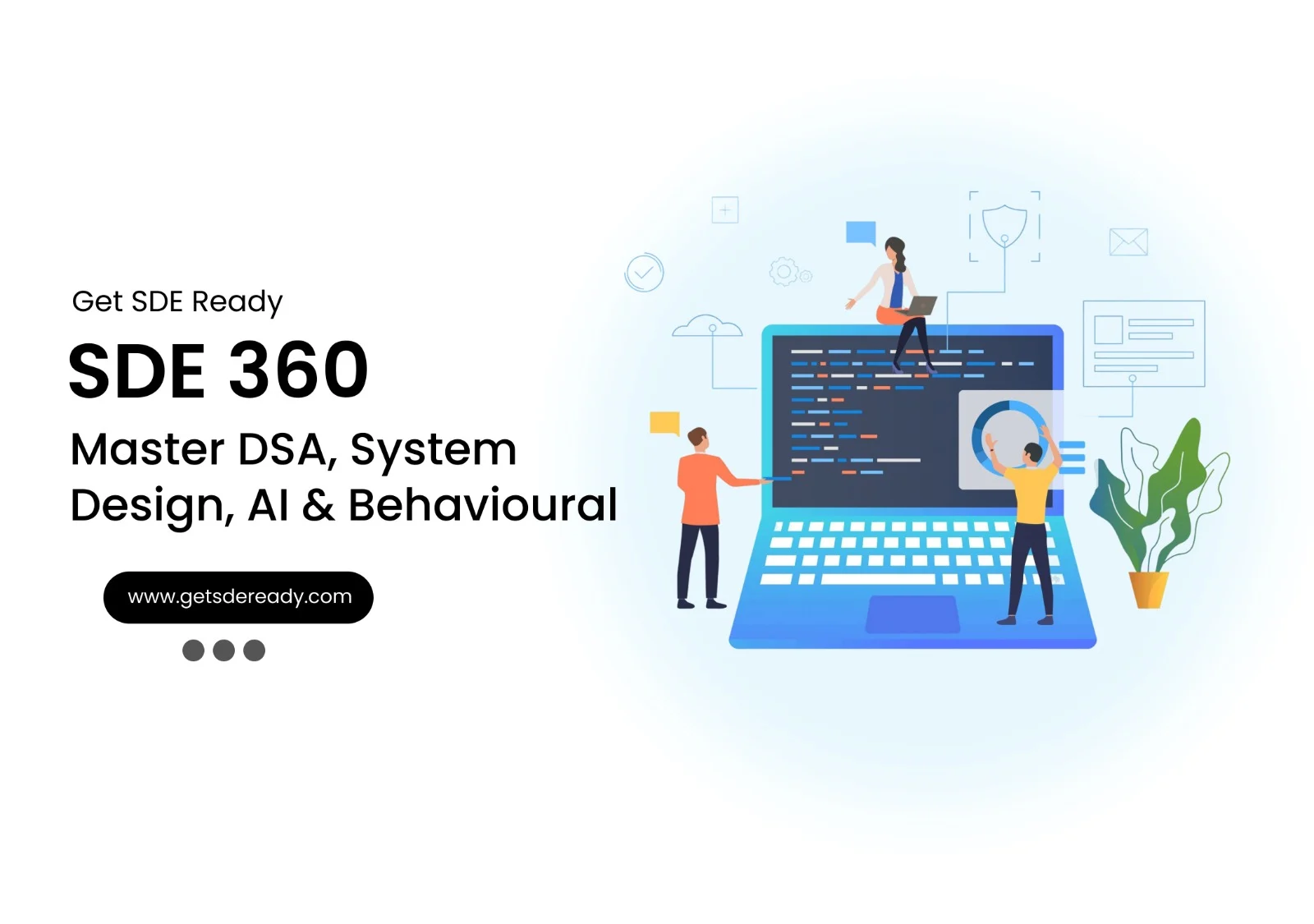
SDE 360: Master DSA, System Design, AI & Behavioural
- 100+ Live Classes & Recordings
- 24*7 Live Doubt Support
- 400+ DSA Practice Questions
- Comprehensive Notes
- HackerRank Tests & Quizzes
- Topic-wise Quizzes
- Case Studies
- Access to Global Peer Community
Buy for 50% OFF
₹39,999.00 ₹19,999.00

DSA, High & Low Level System Designs
- 85+ Live Classes & Recordings
- 24*7 Live Doubt Support
- 400+ DSA Practice Questions
- Comprehensive Notes
- HackerRank Tests & Quizzes
- Topic-wise Quizzes
- Case Studies
- Access to Global Peer Community
Buy for 52% OFF
₹25,000.00 ₹11,999.00
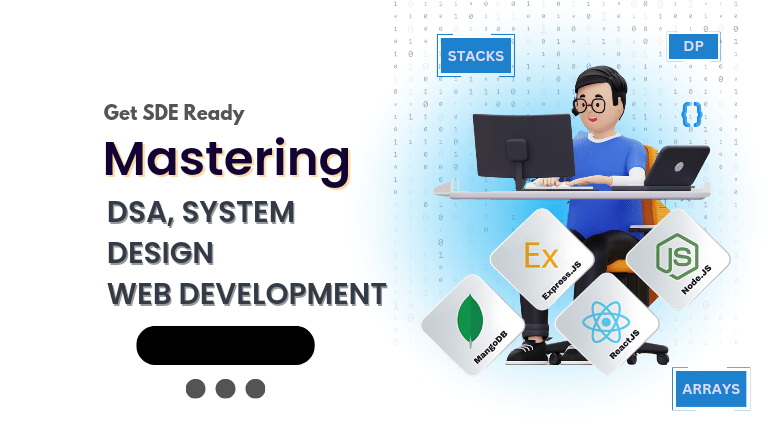
Fast-Track to Full Spectrum Software Engineering
- 120+ Live Classes & Recordings
- 24*7 Live Doubt Support
- 400+ DSA Practice Questions
- Comprehensive Notes
- HackerRank Tests & Quizzes
- 12+ live Projects & Deployments
- Case Studies
- Access to Global Peer Community
Buy for 51% OFF
₹35,000.00 ₹16,999.00
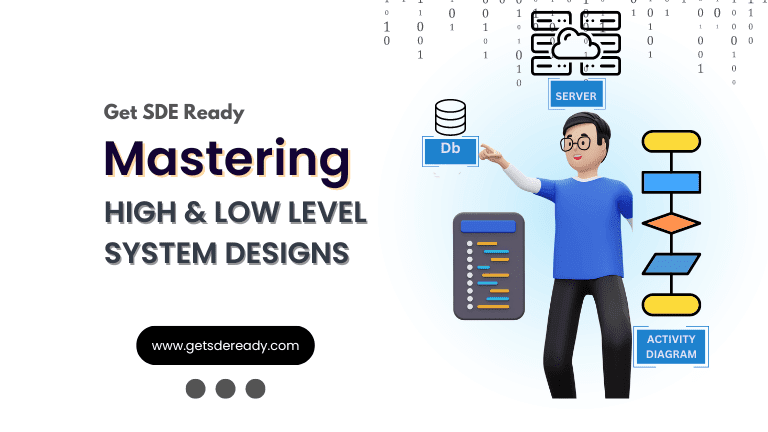
Low & High Level System Design
- 20+ Live Classes & Recordings
- 24*7 Live Doubt Support
- Case Studies
- Comprehensive Notes
- HackerRank Tests
- Topic-wise Quizzes
- Access to Global Peer Community
- Interview Prep Material
Buy for 60% OFF
₹20,000.00 ₹7,999.00
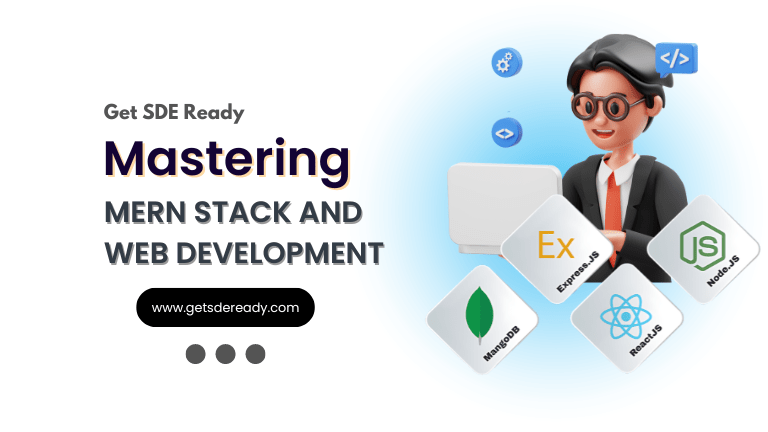
Mastering Mern Stack (WEB DEVELOPMENT)
- 65+ Live Classes & Recordings
- 24*7 Live Doubt Support
- 12+ Hands-on Live Projects & Deployments
- Comprehensive Notes & Quizzes
- Real-world Tools & Technologies
- Access to Global Peer Community
- Interview Prep Material
- Placement Assistance
Buy for 53% OFF
₹15,000.00 ₹6,999.00
Reach Out Now
If you have any queries, please fill out this form. We will surely reach out to you.
Contact Email
Reach us at the following email address.
arun@getsdeready.com
Phone Number
You can reach us by phone as well.
+91-97737 28034
Our Location
Rohini, Sector-3, Delhi-110085
